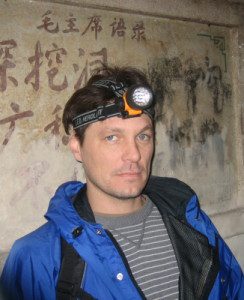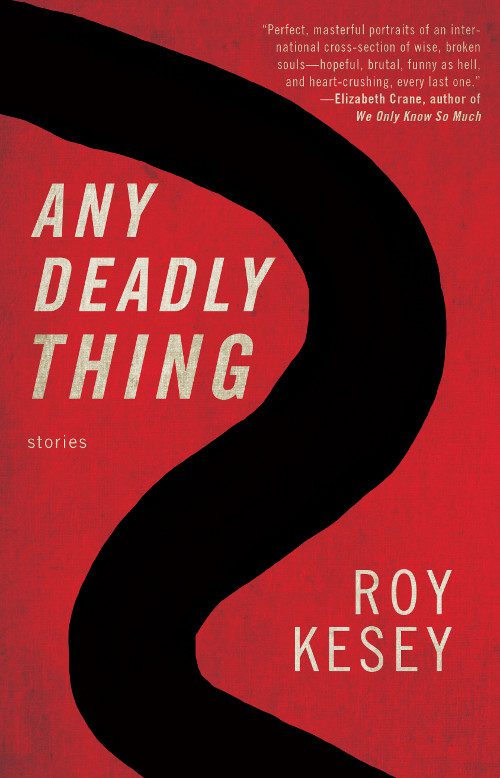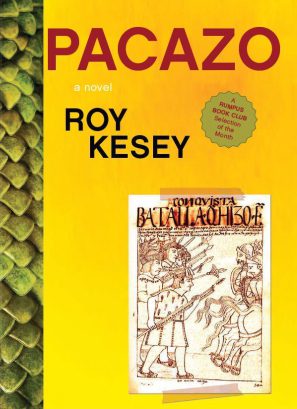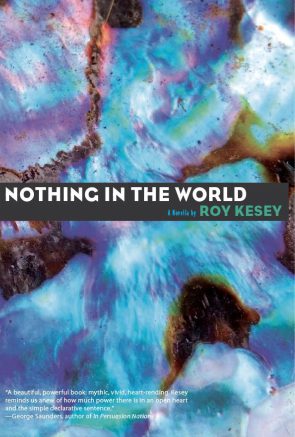
I was introduced to Roy Kesey, and his writing, in what seems now the fledgling days of the Internet—pre-Twitter, pre-Facebook, and even pre-Rumpus. Online, he came across as charming and smart and personable and generous, and when I eventually met him in person, he was all of those things, plus he still had most of his hair.
Roy has had one of those lives that seems like a dozen lives somehow crammed into one. Born in California (“in a red pickup truck,” apocryphally), he has since made his home everywhere from Peru to Croatia to China, recently settling with his family in Maryland. Though “settling” seems an incongruous way to describe anything the guy does: his worldwide adventures aside, he is the author of two story collections, a novel, and a novella, as well as a historical guide to Nanjing, China, all of which evince a desire to constantly challenge himself and push his writing in new directions.
(He also once convinced me that he was Marguerite Duras’s final lover—untrue, it turns out, and though I’m an obvious dupe, such a thing still doesn’t seem beyond the realm of comprehension.)
Roy’s most recent book, Any Deadly Thing, is a collection of stories as adventurous, playful, and strange, as it is profoundly moving and insightful. Shifting from the fabulism of his previous short fiction, here his characters continue to excavate new territories, be they clueless ex-pats blundering their way around foreign locales or well-meaning fathers doing their best, failing, and trying again.
***
The Rumpus: When and where were these stories written?
Roy Kesey: The first draft of the oldest story in Any Deadly Thing was written in 1999 in Piura, Peru. The final draft of the most recent story was written in 2011 in Lima, Peru. In between, there were a bunch split more or less evenly between those two cities, plus a bunch written in Beijing, and a few written in Syracuse.
Rumpus: Of All Over, you admitted to—even celebrated—having written “a book full of stories with nothing whatsoever in common,” but this collection seems to have some clear commonalities throughout. Was it a conscious decision, this time round, to write more directly to and about certain themes and situations?
Kesey: That would be a pretty weird thing to celebrate, but, thinking it over, I’ve probably celebrated weirder ones.
Rumpus: Sure, not to say you were dancing in the streets or anything, just that that title acknowledges the diversity of material and styles, and focuses it.
Kesey: Exactly, the street-dancing itself was a whole other thing.
I guess that in terms of comparing the two collections, the way I’d say it is, while there are certain thematic throughlines in the stories of each one, neither uses theme as first principle or flowchart label or, you know, pie flavor. That said, if the thematic concerns are more clearly seen in Any Deadly Thing than in All Over, I’ll just have to hope that’s a good thing.
Rumpus: All Over had Saunders and Barthelme, um, all over it, but these stories feel a little harder to pin down. Are you moving away from direct influence? And toward something closer to straight realism, maybe?
 Kesey: So, okay, let’s see what happens if I answer the realism/not question first. The answer there is: not exactly. By which I mean, it isn’t that I wrote a bunch of goofy formal experiments for All Over, and then a bunch of sober realist tales for Any Deadly Thing. It was more that I simply decided, back in 2006 when I was getting All Over ready for publication, to use the spectrum of formal experimentation as a way to divide two collections’ worth of stories into two actual collections.
Kesey: So, okay, let’s see what happens if I answer the realism/not question first. The answer there is: not exactly. By which I mean, it isn’t that I wrote a bunch of goofy formal experiments for All Over, and then a bunch of sober realist tales for Any Deadly Thing. It was more that I simply decided, back in 2006 when I was getting All Over ready for publication, to use the spectrum of formal experimentation as a way to divide two collections’ worth of stories into two actual collections.
Of course, the fact that many of the stories in Any Deadly Thing were written after All Over was published makes things more complicated. But I’d feel a little silly denying that lately I’ve moved slightly away from, say, stories like “Interview,” where the structural conceit is front and center, and the prime influence (Barthelme, in that case) is a shiny medal on the story’s chest, and towards, say, stories like “Any Deadly Thing” or “Stump,” where the dictional lineage is a little less clear, even to me, and where the experimentation is more in terms of how a certain (odd) type of consciousness can best be made manifest.
Rumpus: As it does in “Scree,” maybe, in which the narration slides in and out of various states of consciousness. Can you talk about how you were experimenting with diction and structure in that story?
Kesey: Sure. The biggest experiment there—and I was convinced for a really long time that it was going to fail horribly—had to do with this weird thing I do every now and then. Like everyone else, as a reader there are certain things that really rub me the wrong way in fiction—pet bugbears, let’s call them. Most kinds of repetition drive me batty. Dreams in fiction tend to irritate me no end. Lazy italicization. Et cetera. But it seems healthy to me, every so often, to take one of those things and make it the center of some new piece of fiction, as a good-natured “fuck you!” to my aesthetic instincts—just to keep myself honest as to why I feel the way I do about certain tools, why I hold prejudice against this or that technique.
“Scree” was all about the dreams. (Not initially, but once I figured out that that was a way to use these excessively odd fragments that were accreting.) The reason I usually don’t like dreams, especially in realist fiction, is because they almost always cause the stories to fail on their own terms: these dreams don’t feel (in my brain) anything like real dreams. The logic to them is somehow wrong—sometimes egregiously and sometimes only slightly. (There are exceptions. Madison Smartt Bell’s “Finding Natasha” has a dream that works awfully well. And there are others. But not many.)
The goal with “Scree” was to build the story almost entirely of dreams, with only the thinnest throughline of waking time. And then I made up a bunch of other rules, which I followed until it was suddenly more interesting not to follow them. For example, each dream, however long, was to be a single paragraph. The dreams were not to comment on one another, but also not to not comment on one another. There was to be a relationship between each dream and the waking time, but it was not to feel linear or one-to-one. And so on.
So there’s your structure. The diction was determined as always by that of the earliest fragment I got—the first few lines, the exhausted father thinking not-quite-coherently.
Rumpus: So what you’ve got here and elsewhere in Any Deadly Thing, unlike in All Over, is some sort of unreal realism.
Kesey: Well. Realism’s anxieties are not my anxieties, but I think I’ve had its tools close at hand all along. It may be that I’m reaching for them more often than I used to. On the other hand, I’m making no promises for the future. The material itself always gets the last word.
Rumpus: Considering the diversity in your writing, I wonder if you ascribe to the idea of a singular writer’s voice?
 Kesey: Sure. But some writers keep a tighter rein on that than others. For short story collections I’m definitely in the loose-rein camp. You know how some people say that they can only read one story a day from this or that collection? If that’s simply the result of the great tension and power condensed into each piece, all well and good. But just as often, or perhaps more often, and even in very good collections—even in some of the best collections ever written, I would argue—it’s because our “voicier” writers hew so closely to one given set of dictional tics that we as readers can’t read the books all the way through in a single sitting, because if we did, the stories and their narrators would all start to bleed together.
Kesey: Sure. But some writers keep a tighter rein on that than others. For short story collections I’m definitely in the loose-rein camp. You know how some people say that they can only read one story a day from this or that collection? If that’s simply the result of the great tension and power condensed into each piece, all well and good. But just as often, or perhaps more often, and even in very good collections—even in some of the best collections ever written, I would argue—it’s because our “voicier” writers hew so closely to one given set of dictional tics that we as readers can’t read the books all the way through in a single sitting, because if we did, the stories and their narrators would all start to bleed together.
For whatever reason, thus far it’s been important to me not to write that kind of collection. Which means that I’ve spent months playing tic-tac-notecard, trying to get the stories in an order whereby stories that are similar in any given way (diction, narrative stance, setting, plot) are separated by others that aren’t.
Rumpus: Can you talk a bit more about how you organized the stories in Any Deadly Thing?
Kesey: The most basic organizing principle was pretty straightforward, and is frankly pretty common: the shorter of what are by my lights the two most engaging stories goes first, the longer of the two goes at the end, and everything else goes in the middle. (From what I understand, that’s kind of become the received wisdom, like, “Never get involved in a land war in Asia,” or “Stop, drop, and roll,” or “Get your tongue out of that socket right this minute!” Whether or not it’s actually the best of all ideas in any given case is surely up for discussion, but it seemed to work out all right here.)
From there, as I said, it was mainly a matter of keeping like stories apart while using each story to set the table for the next. So the collection moves from a medium-length/Northern California/close third/terse tense 1,000-yard-stare kind of story into a slightly longer/eastern Peru/dense first/talky boisterous naïveté kind of story, and from there into a still-slightly-longer/central China/slightly-less-close third/nervously meditative kind of story, and so on.
What I like about organizing things that way is that each story gets nearly full reign over its own space, but all of them are hung on a single string—the loosely-reined voice mentioned above. Thus the collection jogs away from suzerainty and past federation toward, I guess, alliance. Or maybe call each story a separate house on a single street? Or it’s all a line of dive bars on some wharf front? What the hell, let’s call reading the collection a pub crawl, but with words.
Rumpus: Does that make you the suzerain, then? Who transitions to becoming, what, a sort of benevolent dictator?
Kesey: Nothing benevolent about it. I am the Creator God Who Rules Over All That He Sees, But Also Has to Remember to Walk the Dog, and Get the Roast Out of the Oven in Time, and Who Will Maybe Fold Some Clothes Later On.
Rumpus: Your treatment of fatherhood reminds me of how Louis CK explores his darker instincts and struggles raising kids. Was that a conscious choice?
 Kesey: I start every first draft with voice rather than theme or image or even character as such, so it isn’t like I’m ever rubbing my hands, cackling, “The dad is really going to take it on the chin in this one!” Not in terms of any given story, and certainly not in terms of the collection as a whole. And yet the fact you’ve noticed remains: the collection has seventeen stories, and in seven of them (if we count the ones written from the son’s perspective too—and until just now when I ran the stats I’d have guessed fewer) you’ve got a dad taking it on the chin.
Kesey: I start every first draft with voice rather than theme or image or even character as such, so it isn’t like I’m ever rubbing my hands, cackling, “The dad is really going to take it on the chin in this one!” Not in terms of any given story, and certainly not in terms of the collection as a whole. And yet the fact you’ve noticed remains: the collection has seventeen stories, and in seven of them (if we count the ones written from the son’s perspective too—and until just now when I ran the stats I’d have guessed fewer) you’ve got a dad taking it on the chin.
So what’s the deal? Well, there aren’t any characters much at all like my own father (though I do steal a few of his anecdotes), so I guess all this is riding on my back. Which is fair and just, I think. When you spend so much time trying to father well, and failing, and trying again, and hopefully failing better, it’s going to seep into your work. And when you give yourself permission to explore the grottiest bits of your psyche (like Louis CK) (who totally stole that move from me) (not really), to exaggerate the edge of the rustiest blades of your IRL mind, you’ll occasionally come up with something that holds real power.
Rumpus: What do the dads in, say, “Scree,” “Cochlear,” and/or “Any Deadly Thing” share with your experience of parenting?
Kesey: There are bits of my own experience in all three of those stories, with maybe slightly more in “Scree” than in the other two.
Rumpus: A number of these stories also feature the “innocent abroad,” and how that character’s (American) presence often disrupts local life, or wreaks unwitting (and sometimes witting) havoc. Are you interested in these stories being read politically or allegorically?
Kesey: How’s this: I didn’t intentionally emplace the raw material needed for political/allegorical readings into any of the first drafts, but sooner or later I saw it coming, and I did intentionally not cut it from some of the final drafts. In other words, I’m not particularly interested in encouraging readers to read certain stories that way, but I want to make sure that route’s accessible should anyone be so inclined.
Rumpus: Is there any way in which you’d rather these stories not be read?
Kesey: Well, there are certainly historical examples of people twisting art to fit some bullshit retrograde agenda, and that would really bum me out, or, since I’d likely be dead, it would really bum out the worms that have eaten my opinions. But in the here and now, once I let go of the manuscript, I’m more interested in seeing how the stories make their way in the world than in trying (and surely failing) to control the kind of welcome they get.
Rumpus: Your characters are often outsiders, people on the margins. Do you think fiction is moving away from these sorts of stories, toward narratives told from the inside out, e.g. Diaz, Heti, Franzen, Dunham, etc.?
Kesey: Good question. There are plenty of examples of that these days, though I have a suspicion we could soon come up with enough counterexamples to make the project a little suspect.
I wonder if it’s maybe more a question of picking one’s particular flavor of outsiderness and sticking with it. As you say, my characters (the American ornithologist in Cajamarca, for example) definitely tend to be more outsider-ish than Oscar Wao in some ways, but it’s not like Wao’s coming from the center of privilege and power either. And even if we were to track down a character who is coming from that center—say, DeLillo’s Eric Packer—the author’s still going to place that character outside of something that matters. If you didn’t, I’m not sure you’d end up with much of a story.
Rumpus: But don’t you think Packer is still meant to represent a larger culture, or serve as a window into that culture, versus, say, that alienated “gringo lindo” at the heart of your story “Gorget”? I want to suggest your approach to storytelling is more…French, maybe, though that feels lazy. Unless, of course, you think of your approach to storytelling as somehow French?
 Kesey: 12th century French, no question. Chanson de Roland, that dude laying waste to all those other dudes? That was originally supposed to be called Chanson de Royland, but then there was some copyright deal, I don’t remember exactly.
Kesey: 12th century French, no question. Chanson de Roland, that dude laying waste to all those other dudes? That was originally supposed to be called Chanson de Royland, but then there was some copyright deal, I don’t remember exactly.
But also this: to the extent anyone represents anything, Packer stands in for a tiny culture, I think, clinging to the brain stem of a larger culture. He influences it, to be sure, even controls elements of it for certain moments, but from a profoundly alienated position, the most luxurious of rolling donjons…
Maybe I’m making too much of this, though. I’m happy to accept your premise that most of my central characters are liminal to the world in which they find themselves, perhaps in a way that isn’t altogether widespread in American fiction these days.
Rumpus: See, I’m already doubting that I have any idea what I’m talking about—now, I mean, but also ever, about anything. (Because Karen Russell’s vegan vampires are certainly outsiders, aren’t they?) Anyway. Let’s stick with your characters, who are often down-and-out, yet treated with such sensitivity and grace.
Kesey: Not at all, that was a good question. Karen Russell’s amazing! And thank you.
Rumpus: Do you as a writer feel any moral obligation to tell these stories in a certain way, or struggle representing people less fortunate than you?
Kesey: It’s probably in part a “there but for the grace” kind of thing—I hung out with these people in high school and elsewhere, knew and loved them, love them still. That might be why I occasionally get their voices incoming, and, when I’m lucky, manage to turn them into stories. The fact is, it doesn’t take much of a misstep in this country (or, frankly, most others) to end up barely getting by.
Rumpus: Do you think fiction writers should be concerned with ethical questions?
Kesey: Yes, of course, we should absolutely be concerned with ethical questions—to exactly the same degree as everyone else. It’s never my intention to sneak any kind of sermon into a story—I’ve got no business preaching, and besides, that kind of thing plays poorly in fiction, always has. But if you’re paying attention to human interactions—to the gap between who we are and who we think we are, or the gap between what happened and what we remember—you’re going to end up thinking (obliquely or otherwise) about what it means to act ethically, and I think that’s all to the good.
Rumpus: I guess I was wondering if you think fiction itself should be beholden to some sort of ethical code. Something like the Hippocratic Oath, but in terza rima, maybe.
Kesey: It’s actually just the one commandment: thou shalt startle and enthrall and delight and console in truth, shalt work with all that is in thee to these ends for the whole of each long day upon the land.
Rumpus: But what if you tend to get up at 10:15?
Kesey: That’s the kind of thing that’ll get you smited.
***
Featured image of Roy Kesey © by Adam Pillsbury.




